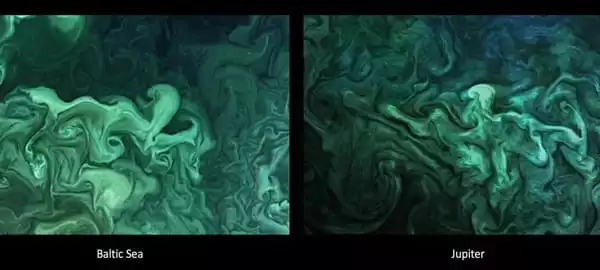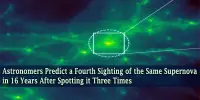Images from NASA’s June Spacecraft have provided oceanographers with the raw materials for a new study that will describe the rich turbulence at Jupiter’s poles as well as the physical forces that drive the large cyclones.
The Juno spacecraft, a NASA-funded satellite that sends images from our solar system’s largest planet to researchers on Earth, is hurtling around Jupiter and its 79 moons. These images provided oceanographers with the raw materials for a new study published today in Nature Physics, which describes the rich turbulence at Jupiter’s poles as well as the physical forces that drive the large cyclones.
Lia Siegelman, a physical oceanographer and postdoctoral scholar at Scripps Institution of Oceanography at the University of California San Diego, decided to pursue the research after noticing similarities between the cyclones at Jupiter’s pole and ocean vortices she studied as a Ph.D. student. Siegelman and colleagues used an array of these images and geophysical fluid dynamics principles to provide evidence for a long-held hypothesis that moist convection (when hotter, less dense air rises) drives these cyclones.
By tracking the movement of the clouds between images, we were able to calculate wind speed and direction from the images. The team then used infrared images to calculate cloud thickness. Hot regions correspond to thin clouds, through which one can see deeper into Jupiter’s atmosphere. The cold regions represent the thick cloud cover that covers Jupiter’s atmosphere.
Lia Siegelman
“When I saw the richness of the turbulence around the Jovian cyclones with all the filaments and smaller eddies, it reminded me of turbulence in the ocean around eddies,” Siegelman said. “These are especially evident on high-resolution satellite images of plankton blooms for example.”
According to Siegelman, understanding Jupiter’s energy system, which is on a much larger scale than Earth’s, could help us understand the physical mechanisms at work on our own planet by highlighting some energy routes that may also exist on Earth. “It’s fascinating to be able to study a planet so far away and find physics that apply there,” she said. “This begs the question, do these processes also apply to our own blue dot?”
Juno is the first spacecraft to photograph Jupiter’s poles; previous satellites orbited the planet’s equatorial region, providing views of the planet’s famous Red Spot. Juno has two camera systems: one for visible light images and another for heat signatures captured by the Jovian Infrared Auroral Mapper (JIRAM), an instrument on the Juno spacecraft supported by the Italian Space Agency.

Siegelman and colleagues examined a collection of infrared images of Jupiter’s north polar region, particularly the polar vortex cluster. By tracking the movement of the clouds between images, the researchers were able to calculate wind speed and direction from the images. The team then used infrared images to calculate cloud thickness. Hot regions correspond to thin clouds, through which one can see deeper into Jupiter’s atmosphere. The cold regions represent the thick cloud cover that covers Jupiter’s atmosphere.
These findings provided the researchers with information about the system’s energy. Because Jovian clouds form when hotter, less dense air rises, the researchers discovered that the rapidly rising air within clouds acts as an energy source, feeding larger scales all the way up to the large circumpolar and polar cyclones.
Juno arrived in the Jovian system in 2016, giving scientists their first look at these massive polar cyclones, which have a radius of about 1,000 kilometers (620 miles). There are eight of these cyclones near Jupiter’s north pole and five near Jupiter’s south pole. Since that first sighting five years ago, these storms have been present. Researchers aren’t sure where they came from or how long they’ve been circulating, but they do know that moist convection is what keeps them going. After observing lightning in Jupiter storms, researchers hypothesized this energy transfer.
Juno will remain in orbit around Jupiter until 2025, providing scientists and the general public with new images of the planet and its extensive lunar system. Seigelman is supported by the Scripps Institution of Oceanography Postdoctoral Program and works in the lab of physical oceanographer William Young, whose research is funded by the National Science Foundation.
















